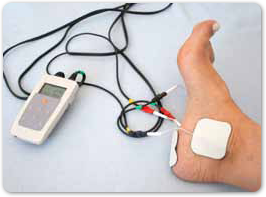
Women older than 40 years of age often experience a condition called “adult-acquired flatfoot” that results in a fallen arch with the foot pointed outward. Symptoms include leg fatigue, pain and swelling that worsens with activity, and body aches. Causes include injury to the nerves of the foot, obesity, bone fracture, diabetes, high blood pressure, rheumatoid arthritis and tight calf muscles that can force the foot out of alignment.
In the early stage, modifying activities that cause discomfort and resting your painful foot is important. Wearing “comfort shoes” for arch support and walking stability, and inserting over-the-counter or custom orthotics can bring further relief. Individuals with a more severe deformity might need to wear a customized brace temporarily to stabilize the foot and ankle before wearing a foot orthotic.
Physical therapy is often advised as a first-line treatment for adult-acquired flatfoot. Heel rises and toe walking exercises strengthen and stretch the tight muscles of your feet, especially the posterior tibial tendon, as do exercises to strengthen hip muscles that control alignment down the lower leg and help lift the arch of the foot.
Because excess weight adds to the problem of adult-acquired flatfoot, weight-loss strategies involving nutritional advice and fitness exercises have helped obese patients experience considerable improvement of their symptoms. Resistance bands, stationary bikes and swimming are safe options to use when a painful foot may make exercising difficult.
Other physical therapy treatments include
- stretching exercises to improve alignment of the foot
- activity modification relevant to your stage of deformity
- heat, ice and ultrasound for pain relief
- specific exercises for sports players
If surgery is necessary to correct the condition, we can work with you and your surgeon postoperatively to minimize pain and swelling and ensure a safe return to your activities. Adult-acquired flatfoot may be a vexing problem, but the many treatment options available can help get you back on your feet—free of pain.
